Unearthed from Prehistoric Seas — Fossil Teeth Found in New Jersey Brooks
Dive into the captivating world of Scapanorhynchus texanus, an extinct relative of the modern goblin shark that prowled the ancient seas during the Late Cretaceous. This in-depth spotlight explores its anatomy, ecology, fossil record, and legacy—highlighting what makes this species a compelling subject for paleontologists and fossil enthusiasts alike.
Scapanorhynchus texanus is an extinct species within the goblin shark family (Mitsukurinidae) that thrived in shallow marine environments during the Late Cretaceous (~100–66 million years ago). Though only known from fossilized teeth, it’s renowned for its slender, striated teeth and elongated snout—traits reminiscent of its modern descendant, Mitsukurina owstoni, yet functionally distinct.
Taxonomy: Belongs to Mitsukurinidae, alongside modern goblin sharks and other extinct genera.
Temporal Range: Spanned from the Aptian to Maastrichtian stages of the Cretaceous.
Geographical Spread: Fossils found across North America (Texas, New Jersey, Mississippi, South Carolina) and beyond.
Fossil remains of S. texanus predominantly come from Late Cretaceous sedimentary deposits in eastern North America. These specimens provide insight into the shark’s ecology and paleoenvironments.
Common Localities: Black Creek Group (NC), Peedee Formation (NC), Big Brook (NJ), Mississippi coastal plain.
Habitat: Shallow marine to continental shelf settings suggest a coastal lifestyle.
Paleoecological Insights: Isotopic studies confirm its role as a mid-to-top-level predator in its ecosystem.
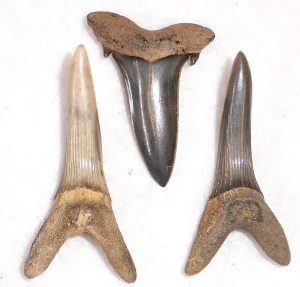 Chondro-fossil evidence is scarce, so most knowledge comes from distinctive fossil teeth. These teeth reveal significant functional adaptations.
Chondro-fossil evidence is scarce, so most knowledge comes from distinctive fossil teeth. These teeth reveal significant functional adaptations.
Anterior Teeth: Long, slender, heavily striated—adapted for grasping prey.
Lateral Teeth: Broader, flatter with 1–3 cusplets—ideal for cutting.
Root Features: Bilobate roots with deep nutrient grooves and cusplets in some specimens.
Comparison to Modern Goblin: Shares general goblin-like tooth form but exhibits more varied (grasping + cutting) dentition.
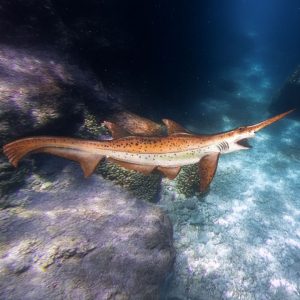 Unlike its deep-sea modern relatives, S. texanus likely inhabited coastal regions and pursued an active predatory lifestyle. Ecology inferred from depositional context and isotopic data.
Unlike its deep-sea modern relatives, S. texanus likely inhabited coastal regions and pursued an active predatory lifestyle. Ecology inferred from depositional context and isotopic data.
Feeding Strategy: Combining grasping and cutting suggests a broad diet—likely fish and invertebrates.
Habitat Adaptation: Found in shallow-water sediments, indicating tolerance for coastal and possibly brackish environments.
Extinction: Possibly wiped out by Cretaceous–Paleogene extinction, which affected active predators severely.
Scapanorhynchus helps illuminate the evolutionary journey of the goblin shark lineage—showing early diversity within Mitsukurinidae and evolutionary trends in shark ecology.
Early Goblin Lineage: S. texanus was among the earliest described mitsukurinids, predating the modern goblin shark.
Morphological Evolution: Its cutting-adapted teeth suggest a transitional morphology between grasping and modern specialized feeding styles.
Systematic Debate: Close skull and tooth similarities have led some to consider merging it into Mitsukurina.
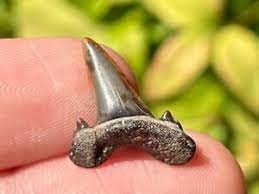
Fossil enthusiasts often seek S. texanus teeth due to their distinctive appearance and abundance. Here’s how to identify and locate them:
Identification Features:
Striated enamel on anteriors and root.
Bilobate roots with deep grooves and occasional cusplets.
Lateral teeth broader with additional cusplets.
Where to Hunt:
Black Creek Group (NC), Big Brook (NJ), coastal sites in SC and MS.
 The living goblin shark (Mitsukurina owstoni) shares many traits with Scapanorhynchus, but differs in habitat and feeding specialization.
The living goblin shark (Mitsukurina owstoni) shares many traits with Scapanorhynchus, but differs in habitat and feeding specialization.
Deep-Sea Adaptation: Modern goblin sharks inhabit depths over 300 m, with sluggish, opportunistic behavior.
Exploding Jaws: Both exhibit protrusible jaws—a specialized feature seen in the family.
Body Size: Scapanorhynchus likely reached ~4 m, potentially up to 6.7 m based on tooth size.
Evolutionary Path: Reflects a transition from coastal predator to deep-sea specialist.
As a well-represented Cretaceous goblin shark, S. texanus offers invaluable insight into shark evolution, paleoecology, and fossil identification.
Educational Value: Helps teach about shark evolution and marine ecosystems of the Late Cretaceous.
Research Applications: Isotope ratios in teeth inform on trophic levels and habitat use .
Collector Appeal: Abundant and recognizable, its teeth remain a popular fossil for enthusiasts.
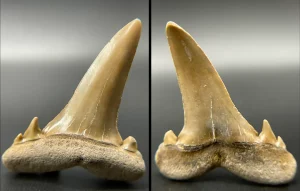 New Jersey is one of the most important fossil shark tooth localities for Scapanorhynchus texanus on the East Coast of the United States. The state’s Late Cretaceous marine deposits have yielded thousands of shark teeth, including a diverse array from the Mitsukurinidae family. Among them, S. texanus remains a highly sought-after and identifiable species for both professional paleontologists and amateur collectors.
New Jersey is one of the most important fossil shark tooth localities for Scapanorhynchus texanus on the East Coast of the United States. The state’s Late Cretaceous marine deposits have yielded thousands of shark teeth, including a diverse array from the Mitsukurinidae family. Among them, S. texanus remains a highly sought-after and identifiable species for both professional paleontologists and amateur collectors.
The teeth of Scapanorhynchus texanus found in New Jersey are known for their sleek, elongated appearance and fine vertical striations. While entire skeletons have never been recovered, these isolated teeth provide a wealth of information about this ancient goblin shark relative and the ecosystem it inhabited.
Big Brook Preserve (Monmouth County)
One of the most popular and accessible fossil collecting locations in New Jersey. Teeth of S. texanus are regularly found here, typically showing light to dark brown coloration and fine vertical ridges.
Shark River (Monmouth County)
Known for an abundance of Late Cretaceous marine fossils. Scapanorhynchus teeth here are often found alongside those of Squalicorax, Cretolamna, and Carcharias species.
Crosswicks Creek and Ramanessin Brook
These brooks have yielded some beautifully preserved S. texanus specimens. Tooth size, condition, and coloration vary depending on erosion and exposure, but identification is made easier by the characteristic narrow crown and striations.
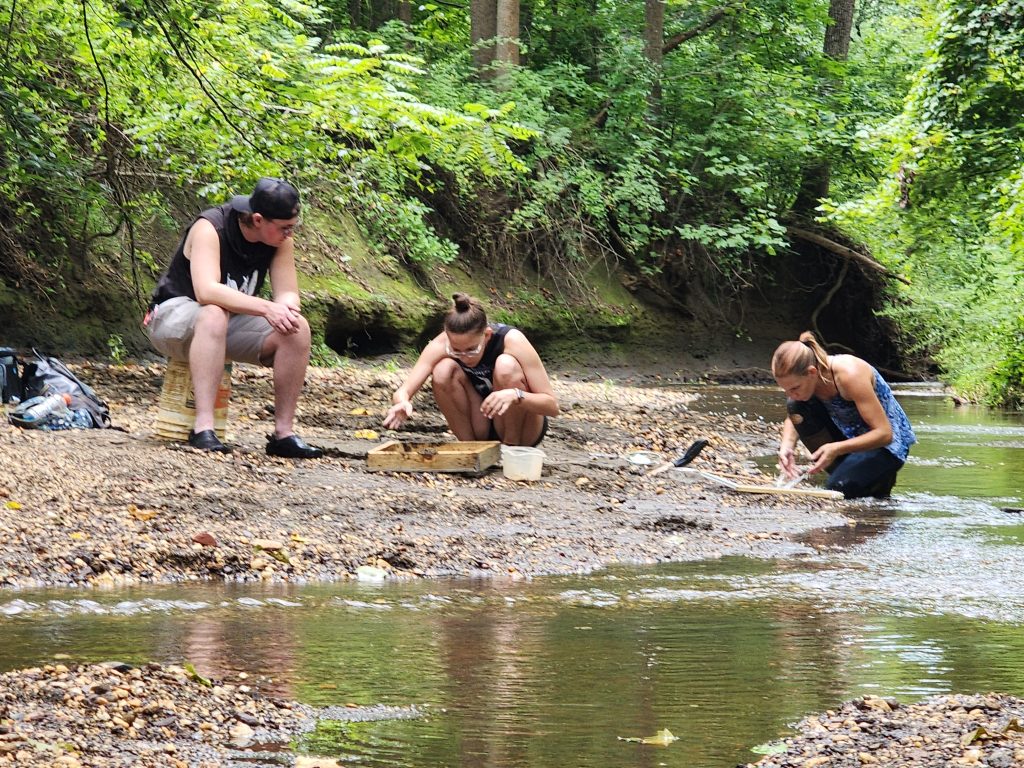
Identifying S. texanus Teeth
Look for thin, blade-like crowns with subtle vertical striations.
Roots are generally small, bilobate, and not as robust as other shark species from the same formations.
Geological Formations
Most S. texanus fossils in NJ come from the Navesink and Hornerstown Formations, both of which represent shallow marine environments from the Maastrichtian stage of the Late Cretaceous.
Best Times to Hunt
After rainfall, when water has exposed fresh gravel and moved sediment.
Winter and early spring months often provide less plant growth and easier access to creek beds.
Legal & Ethical Collecting
Most sites in New Jersey allow surface collecting only—digging into the banks or using tools is prohibited.
Always obtain permission if collecting on private land, and follow local fossil hunting guidelines to preserve these valuable educational sites.
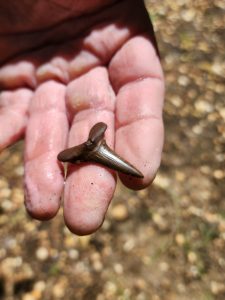 New Jersey provides a rare opportunity to experience fossil hunting in a suburban environment with global scientific significance. The state’s Scapanorhynchus texanus finds help reconstruct the Late Cretaceous marine food web and offer a tangible link to one of the strangest and most elusive shark families ever known.
New Jersey provides a rare opportunity to experience fossil hunting in a suburban environment with global scientific significance. The state’s Scapanorhynchus texanus finds help reconstruct the Late Cretaceous marine food web and offer a tangible link to one of the strangest and most elusive shark families ever known.
Collectors in New Jersey have the unique privilege of uncovering real pieces of prehistoric history. Whether you’re a child exploring Big Brook for the first time or a seasoned fossil enthusiast adding to your collection, every S. texanus tooth you find carries the story of an ancient predator that once swam just offshore—millions of years before humans ever walked the Earth.
Scapanorhynchus texanus stands as a remarkable representative of prehistoric sharks—a coastal cousin to today’s deep-sea goblin shark. Its unique blend of grasping and cutting dentition offers a glimpse into an evolutionary branch that adapted to active predation in ancient seas. As we uncover more fossils and refine methods, the story of these spade-snouted hunters continues to unfold.
Curious fossil enthusiasts and collectors can look for characteristic striated teeth in Cretaceous sediments along the eastern US, where S. texanus still graces rock-hunting sites with its ancient presence.
Tip: Join the New Jersey Shark Tooth Hunters Facebook group to see recent Goblin Shark tooth finds, learn hunting tips, and connect with others who share your passion for fossils.